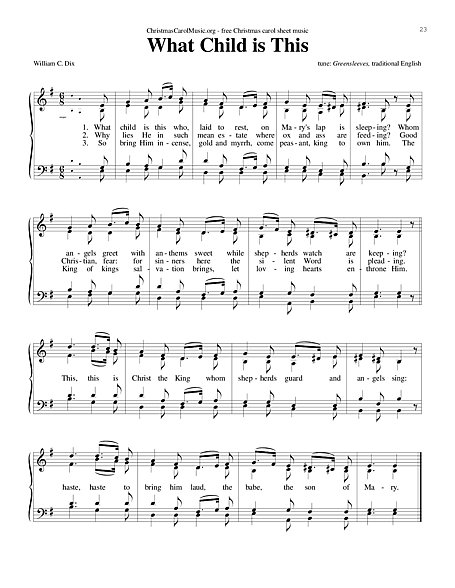Greensleeves
What Child is This?

- Kompozytor
- Tradycyjny
- Strony
- 1
- Instrumenty
- SATB
- Tekst
- William Chatterton Dix
- Typ
- Kolęda, Folk song
- Licencja
- Choral Public Domain License
- Dodane przez
- Music Library
- Wielkość pliku
- 62.0 KB
Recenzje
Kliknij aby ocenić
O...
From the Christmas Carol Songbook:
cantorion.org/ ... tmas-Carol-Songbook-Voice-SATB
"What Child Is This?" is a Christmas carol whose lyrics were written by William Chatterton Dix, in 1865. At the time of composing the carol, Dix worked as an insurance company manager and had been struck by a severe illness. While recovering, he underwent a spiritual renewal that led him to write several hymns, including lyrics to this carol that was subsequently set to the tune of "Greensleeves", a traditional English folk song. Although it was written in Great Britain, the carol is more popular in the United States than in its country of origin today.
Powyższy tekst jest udostępniany na licencji Creative Commons Attribution-ShareAlike. Zawiera treść z artykułu z Wikipedii "What Child Is This?".
cantorion.org/ ... tmas-Carol-Songbook-Voice-SATB
"What Child Is This?" is a Christmas carol whose lyrics were written by William Chatterton Dix, in 1865. At the time of composing the carol, Dix worked as an insurance company manager and had been struck by a severe illness. While recovering, he underwent a spiritual renewal that led him to write several hymns, including lyrics to this carol that was subsequently set to the tune of "Greensleeves", a traditional English folk song. Although it was written in Great Britain, the carol is more popular in the United States than in its country of origin today.
Powyższy tekst jest udostępniany na licencji Creative Commons Attribution-ShareAlike. Zawiera treść z artykułu z Wikipedii "What Child Is This?".
O Greensleeves
Greensleeves to angielska piosenka ludowa. Autorstwo przypisuje się Henrykowi VIII (1491–1547), który miał ją stworzyć dla Anny Boleyn, późniejszej jego żony i królowej Anglii. Legenda ta nie została jednak potwierdzona, a styl w którym utwór został napisany nie był znany w Anglii za życia króla. Piosenka pochodzi najprawdopodobniej z drugiej połowy XVI wieku. Pierwsza znana wersja drukowana została w roku 1580 wymieniona w London Stationer's Company pod tytułem A New Northern Dittye of the Lady Greene Sleeves, ale żaden jej egzemplarz nie zachował się. W komedii Wesołe niewiasty z Windsoru autorstwa Williama Szekspira, wydrukowanej po raz pierwszy w 1602 roku, znajduje się kilka odwołań do melodii Greensleeves bez żadnych dodatkowych komentarzy ze strony autora, co wskazuje na to, że melodia ta na przełomie XVI i XVII wieku była już powszechnie znana.
Powyższy tekst jest udostępniany na licencji Creative Commons Attribution-ShareAlike. Zawiera treść z artykułu z Wikipedii "Greensleeves".
Powyższy tekst jest udostępniany na licencji Creative Commons Attribution-ShareAlike. Zawiera treść z artykułu z Wikipedii "Greensleeves".
Inne aranżacje
Buy printed editions
We have selected some printed editions we think may be useful.
- What Child Is This Greensleeves A Cappella
- 6,85 zł
- Choral, Vocal
- G. Schirmer
- Greensleeves
- 182,61 zł
- Jazz ensemble
- Alfred Publishing
More music by Tradycyjny
 ♪
♪- Auld Lang Syne
Dźwięk, Fortepian
- Auld Lang Syne
 HQ
HQ- Amazing Grace
Violin duet - Skrzypce
- Amazing Grace
 ♪HQ
♪HQ- Amazing Grace
Dźwięk, SATB
- Amazing Grace
 ♪HQ
♪HQ ♪HQ
♪HQ- Hymn Wielkiej Brytanii
Fortepian, Dźwięk
- Hymn Wielkiej Brytanii
Other users also liked

- Requiem Mass
- Wolfgang Amadeusz Mozart
- Requiem Mass

- Kantata 14
Vocal score - Johann Sebastian Bach
- Dźwięk, Klawiatura, Fortepian
- Kantata 14

- Kantata 40
Full score - Johann Sebastian Bach
- Dźwięk, Orkiestra
- Kantata 40

- Songs from Schiller's Wilhelm Tell
1st Version - Ferenc Liszt
- Dźwięk, Fortepian
- Songs from Schiller's Wilhelm Tell

- Kantata 14
Full score - Johann Sebastian Bach
- Dźwięk, Orkiestra
- Kantata 14













